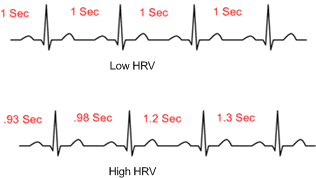What is HRV?
HRV stands for Heart Rate Variability and measures the variance in time between heartbeats. Even if your heart rate is consistent, your heartbeats are not separated in time equally — sometimes there is more time between two beats and sometimes there is less time. Studies show that the greater the variability, the more prepared you are to exercise.
How is HRV measured?
On the SlateSafety Platform, HRV is measured in milliseconds (ms). This measurement corresponds to the milliseconds between heartbeats. In both the High HRV and Low HRV examples below the heart rate is 60 BPM — meaning on average there is one heart beat per second. But as you can see, the High HRV measurement has more variance in between heart beats.

The Heart Rates for both lines are the same, but the variability between heart beats is very different.
Source: sweetwaterhrv.com
When is HRV measured?
HRV is most easily recorded during periods without motion. The is because HRV is especially sensitive to noise since it depends on capturing very precise intervals between heartbeats. Motion naturally makes it harder for sensors to capture these heartbeat intervals. To help your BAND V2 record HRV, try having more periods with minimal motion.
What is HRV used for?
HRV is a fitness metric that can be used to determine readiness for exercise. If your HRV is high, you are ready for exercise. If your HRV is low, you may need rest. If you consistently exercise, your HRV will likely increase over time. But on days after intense exercise, HRV will be lower because your body needs to recover.
| Low HRV | High HRV |
| Needs rest | Well rested |
| Low Adaptability | High Adaptability |
| Decreased Cognition | Increased Cognition |
What is a good HRV?
HRV can be relative to each individual, but typically HRV values can be summarized by the table below.
| Needs rest | Fairly rested | Well rested |
| Below 30 ms | 30-60 ms | Over 60 ms |